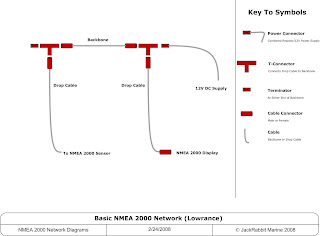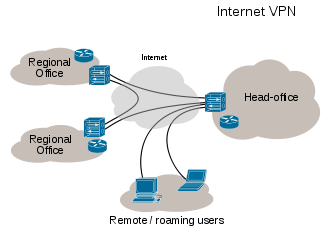
NMEA 2000 is a marine networking protocol or a SeaTalk NG network is defined by the NMEA (National Marine Electronics Association) . The standard defines a means of connecting devices to a common data bus so that these devices can exchange information. The structure of the network as it will be seen in recreational boats is that there is a single backbone cable running the length of the boat, with drop cables going from the backbone to individual devices. The drop cables connect to the backbone by means of T-connectors. The network carries both data and power. A special T-connector provides 12V power to the network, and most smaller devices can be powered by the network itself and do not need their own power cables. The standard covers both the physical structure of the network (topology, cable specifications, connector specifications etc) and the higher-level protocols that allow messages to be exchanged.
The network functions at a much higher speed than existing standards such as NMEA 0183 or SeaTalk. NMEA 2000 is designed for status and control messages such as a GPS position; a depth or wind speed; a liquid tank level indicator; an instruction to turn a relay on or off; engine status data; compass data; autopilot data and other messages of this type. However, it is not as fast as an Ethernet-based system would be. It does not have the bandwidth to transmit radar data, or sonar data.
The most important aspect of the NMEA 2000 standard from the point of view of manufacturers and consumers is that equipment cannot be sold as NMEA 2000 compliant unless it has passed a set of tests to validate that compliance. All manufacturers can design to the standard knowing that their equipment will plug into an existing network and immediately be able to communicate with all other equipment on the network. Consumers can buy equipment from any manufacturer and know that it is guaranteed compatible with their existing setup, with no special interfacing needed. Just plug it into the backbone and go.
NMEA 2000 has been around for a few years now, as its name indicates. Progress in adopting the standard has been slow until just recently, but in the last half of 2007 all the major manufacturers have jumped on board the train. Raymarine has launched its SeaTalk NG network which is NMEA 2000 with a non-standard physical layer (but inter-operable); Furuno has announced NavNet 3D with full standard NMEA 2000 networking, and the FI-50 line of NMEA 2000 instruments and transducers; Garmin has the 4000 and 5000 series displays, has announced new NMEA 2000 instruments, a GPS antenna and an autopilot, and will launch its own cabling; Lowrance has a full range of sensors, displays, engine interfaces and cabling; Simrad has its own Simnet which is inter-operable. Airmar makes NMEA 2000 transducers; Maretron continues to provide cabling, sensors and gateways; Offshore Systems focusses on tank senders and displays; and Actisense has gateways.

Your Friend

- Manpreet Singh Bindra
- PATIALA, PUNJAB, India
- Please Give Your Valuable Feedback manpreetsinghbindra@hotmail.com
Search Of Your Interest
4G Technology
(1)
AIRTEL Success Story
(1)
AREA NETWORKS
(1)
Apple 3G iPhones Improving Networking
(1)
BSNL DATAONE broadband disconnect problem
(1)
Basic Concept Of TELECOMMUNICATIONS SYSTEM
(1)
Basic and Simple Definition to 3G
(1)
Business Network
(1)
Business Strategy for Growth
(1)
Business Wireless Planning Strategy
(1)
CCTV IP camera
(1)
CISCO : how IGRP make large INTERNETWORKS in organizations
(1)
CISCO Solutions Provide
(1)
CTT6800+ -JPEG 2000 Compressed Transport Transceiver
(1)
Change of IP Address
(1)
Connectionless packet switching and routing
(1)
Core Network of 3G
(1)
Core Networking In MICROSOFT WINDOWS SERVER 2003
(1)
Current Protocols Essential Laboratory Techniques (CPET)
(1)
Difference between 2G - 3G - 4G & What is 4G & its Advantages ?
(1)
Different Business Networking Types
(1)
DirectX proportional to Networking
(1)
FREE Wi-Fi
(1)
Finisar :Traffic Generation
(1)
Fox Business Network
(1)
GPRS Core Network
(1)
HBR Technologies (HBR)
(1)
HOW TELEPHONE NETWORK SYSTEM WORKS
(1)
History of packet switching
(1)
How To Setup Wireless Connection(APPLY SAFETY SETTINGS FIRST)
(1)
How to Network 2 Computers Without a Hub or Router
(1)
How to Use a Wireless Network Connection with a Windows XP Portable Computer at Home and Work
(1)
How to make a proper website on NETWORKING
(1)
How to troubleshoot wireless network connections in Windows XP Service Pack 2
(1)
IP Addresses
(1)
Importance of BANDWIDTH in DSL Internet Connections
(1)
Internet and its Component
(1)
Introduction to LAN
(1)
Is Your Networking Caught A Virus?
(1)
Long Term Evolution (LTE)
(1)
MICROSOFT the WORLD WIDE LEADER in NETWORKING
(1)
Multi-Core Processing
(1)
Multi-core networking
(1)
NETWORKING CORE
(1)
NETWORKING IN MEDICAL APPLIANCES
(1)
NORTELVisitor-Based Networking Solution
(1)
Network Design
(1)
Network Protocols
(1)
Nokia Dual Sim Phones
(1)
OPTICAL CHARACTERISTICS OF LEDS
(1)
Packet switching in networks
(1)
Pressure Swing Adsorption(PSA)
(1)
Proxy Servers HIDE IP address from WEB NOT other INFORMATION
(1)
Purpose of Business Network or Networking
(1)
Role of EGP and BGP in the TCP/IP (Exterior Routing Protocols)
(1)
SOLUTION Providers to NETWORK Companies
(1)
STP topology of a Switched Network
(1)
STRUCTURED CABLES IN TELECOMMUNICATION
(1)
SeaTalk NG network
(1)
Setting Priorities for Next-Generation Web Apps - MICROSOFT
(1)
Social Network Services
(1)
Social Networking Services to Expand Business
(1)
Speed UP Your PC in 3 Easy Steps
(1)
Spyware affecting Networking
(1)
Sysinternals File and Disk Utilities
(1)
Sysinternals Networking Utilities
(1)
Sysinternals Security Utilities
(1)
TENA and NetAcquire
(1)
UNIX Network Security Architecture
(1)
WAN and Home Networking
(1)
What Network Administrators Think of NETWORKS
(1)
What Nortel Solutions can Provide? Case Study
(1)
Why Not Reserved IPs on Internet
(1)
WiMAX
(1)
Wireless Code Division Multiple Access (CDMA)
(1)
koollage-blogs-news
(1)
~ (DDBMS) DISTRIBUTED DATABASE MANAGEMENT SYSTEM
(1)
~ ActiveVideo system
(1)
~ Advanced Shellcoding Techniques
(1)
~ Cisco VTP: VLAN Trunking Protocol
(1)
~ Features of the Web
(1)
~ How Core Networking Solve Problems?( Solutions provided by Core Networking)
(1)
~ Modulation Techniques for Wireless
(1)
~ Trillium Multi-Core Software
(1)
~ Wi-Fi Networking News
(1)
Core Networking

SeaTalk NG network
Labels: SeaTalk NG network
Subscribe to:
Post Comments (Atom)


0 comments:
Post a Comment